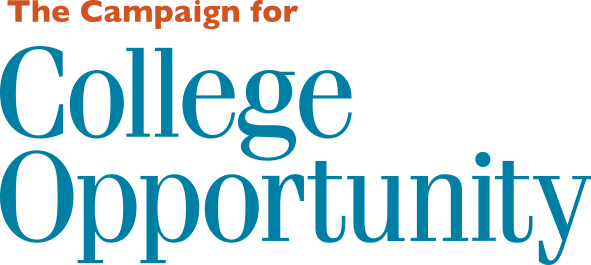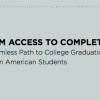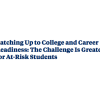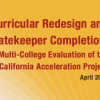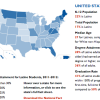
For many California students, higher education is a path out of poverty. That is the case for Toni Gomez, 22, from Susanville, California, a small Northern California town that was once a mining and logging boomtown but which now houses two large correctional facilities.
Though her parents are a real estate agent and a contractor, small town life was not always easy for the Gomez family. For much of her youth, the family was on public assistance as her mother battled substance addiction. Despite these hardships, Toni was bright and excelled in school. She was a student in the Gifted and Talented Program (GATE) and an enthusiastic FFA Club member. Toni describes her parents as “hippies” who encouraged learning through curiosity, exploration and entrepreneurialism. The pursuit of higher education was neither discouraged nor encouraged.
After graduating from Lassen High School in 2006, Toni had no plans to attend college. She worked for a year at a church in Vallejo, California, and when it became clear that church work was not her calling, Toni’s mom suggested she explore business development classes at Shasta Community College (SCC). While working full-time at a furniture store, Toni enrolled in a few online courses through SCC.
When she applied for financial aid, her application was selected for “verification,” a random audit process intended to protect against fraud. The verification process required that Toni provide copies of her tax return, her parent’s tax return, and additional financial documents she had never heard of. The red tape was overwhelming, and Toni simply could not comply. “Neither of my parents had filed taxes in three years. Without their tax return there was no way to verify their income. After a few attempts to contact the Financial Aid Department, I gave up.”
A recent study by The Institute for College Access and Success found that students selected for “verification” were 7% less likely to receive the financial aid for which they were eligible than those who were not selected. This was certainly true of Toni. Without financial aid, she could not afford the class fees. She stopped attending and was dropped from all her classes. Her first college semester was a lost one, an unintended consequence of a financial aid safeguard.
Determined to try again, Toni enrolled the following semester. This time, she flourished and thrived.
“Eventually, I bought into college. I watched my parents struggle, and I began to see college as the route to a stable future, as the way out of poverty,”
she says. Her outlook changed, as did her commitment to higher education. She enrolled in college track courses, taking 15 or 16 units per semester. She enrolled during the summer session. Simultaneously, she took online classes at SCC and classroom courses at nearby Lassen Community College (LCC).
But obstacles stemming from the financial aid system persisted. The fall session begins in mid August, but at LCC and at many other colleges, student loans and grants aren’t disbursed until October. “That’s the frustrating part about the financial aid system, the way it is that it takes them so long to get the students the money that they need,” Toni says. “Students are being asked to buy $250 books and supplies for classes, but they don’t have any money. If you don’t have a textbook in a class, you can’t succeed in the class.”
Toni admits that she did achieve a B grade in a class even though she never purchased one of the required textbooks. The class was English 1A, and it examined society, community, and culture through food. Actually, she found the course to be very interesting. “Unfortunately one of the books the professor wanted us to read was $66 and I didn’t have $66, so I would borrow it after class from a classmate or copy pages or read it in the library. I made it work.” Toni says other students do the same: “They are forced to photocopy portions of the book.”
Last year, Toni served as LCC’s associated student body president. Her office was located in the campus food pantry.
“We have a food pantry at our college because we were concerned that our students were not eating. I think that’s the case at a lot of colleges. You’ll see students starting food pantries just to make sure students are being fed. Our students are hungry,” Toni said. “That’s kind of crazy, isn’t it? It’s weird that we’re stepping in to fill that social service.”
As a college student, Toni has lived close to the edge of poverty. “The experience of being a student is extremely difficult,” Toni says. Once, Toni survived for two months with only $34 in her bank account. She survived by working odd jobs to scrape together cash. She carpooled to school with her neighbor and also depended on food stamps. “The thing about life is when you run out of money, you don’t just fall over and die. You have to keep going. That’s a reality that a lot of our students face, especially in August and September when they are waiting on their financial aid checks to come through.” Toni has made every effort to connect students to the food stamp program. But for a full-time student to be eligible for food stamps, she or he must work a minimum of 20 hours per week. “There’s a little contradiction there,” Toni notes.
Toni is currently helping her friend Susan, a single mother of two children, enroll in LCC. Specifically, she helps Susan submit forms and directs her to resources that are available to her: “It’s important to tell her that she can get a free bus pass.” Other resources like ASSIST.org, an easy-to-use website that shows students how course credits earned at one public California college or university transfer to another public California institution, are indispensible. “It’s a great tool that not a lot of students know about,” Toni says. “Making students aware of the resources that are available to them has been the biggest way to help them through the road blocks.”
LCC also has a “10-step enrollment” process that Toni prefers to call “a 10-step hazing process.” A prospective student must enroll in person, and no part of the application can be completed online. Between the admissions documents, the financial aid documents, Board of Governors (BOG) Fee Waiver (waives tuition fees for low-income students), and the long lines, students are easily overwhelmed by the process. Many times students who work simply do not have free the time it takes to complete the process. “I have seen students who get frustrated with the system,
and they have just walked away. They say ‘I can get a full-time job. I can get $10 an hour—why would I use my time to do this?’
’ It’s important to recognize that time spent in class for community college students is a trade off. They could be somewhere else making money, so when we put these roadblocks in front of them, we’re telling them that they should go work because it is going to be more profitable for them,”
said Toni.
This fall, Toni will transfer to Mills College, an all-women’s college up the road in Oakland, California, to pursue a degree in public policy. She looks forward to the rigorous academic environment and to upper division courses like Economics and Education, eve if she doesn’t look forward to purchasing the textbook for the course.
Student Success Indicator
Clear communication to students of financial aid options available to them. Toni didn’t have any of her own financial resources to contribute to paying for college. Many face similar situations, but do not know what their options are. In 2007-08, an estimated 500,000 community college students were likely eligible for federal or institutional grant aid but did not apply for it.*
SOURCE: *The Institute for College Access & Success (March 2010). Financial Aid Facts at California
Community Colleges. Oakland, CA.
